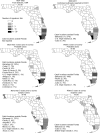Epidemiology of Ciguatera in Florida
- PMID: 26123957
- PMCID: PMC4530775
- DOI: 10.4269/ajtmh.14-0400
Epidemiology of Ciguatera in Florida
Abstract
Ciguatera is the most commonly reported marine food-borne illness worldwide. Because there is a biological plausibility that ciguatera may be impacted by long-term climate variability and Florida is on the northern border of the geographic distribution of ciguatera, it is important to update our understanding of its epidemiology in Florida. We performed an analysis of 291 reports in Florida from 2000 to 2011 and an e-mail survey of 5,352 recreational fishers to estimate incidence and underreporting and identify high risk demographic groups, fish types, and catch locations. Incidence was 5.6 per 100,000 adjusted for underreporting. Hispanics had the highest incidence rate (relative risk [RR] = 3.4) and were more likely to eat barracuda than non-Hispanics. The most common catch locations for ciguatera-causing fish were the Bahamas and Florida Keys. Cases caused by fish from northern Florida were infrequent. These results indicate that ciguatera incidence is higher than estimated from public health reports alone. There is little evidence that incidence or geographic range has increased because of increased seawater temperatures since earlier studies.
© The American Society of Tropical Medicine and Hygiene.
Figures



References
-
- Bagnis R, Chanteau S, Chungue E, Hurtel JM, Yasumoto T, Inoue A. Origins of ciguatera fish poisoning: a new dinoflagellate, Gambierdiscus toxicus Adachi and Fukuyo, definitively involved as a causal agent. Toxicon. 1980;18:199–208. - PubMed
-
- Lewis RJ, Ruff TA. Ciguatera—ecological, clinical, and socioeconomic perspectives. Crit Rev Environ Sci Technol. 1993;23:137–156.
-
- Dickey RW, Plakas SM. Ciguatera: a public health perspective. Toxicon. 2010;56:123–136. - PubMed
-
- Lewis RJ. The changing face of ciguatera. Toxicon. 2001;39:97–106. - PubMed
Publication types
MeSH terms
Grants and funding
LinkOut - more resources
Full Text Sources
Other Literature Sources

